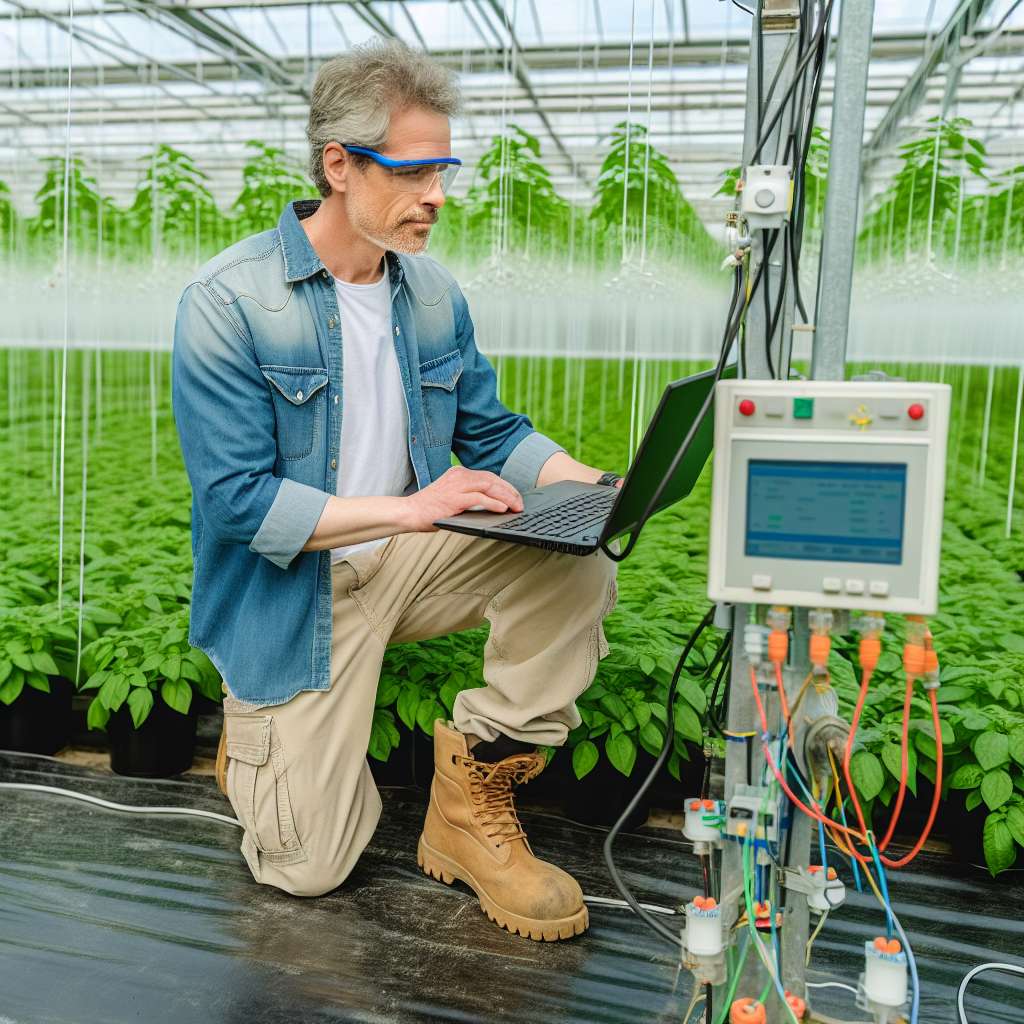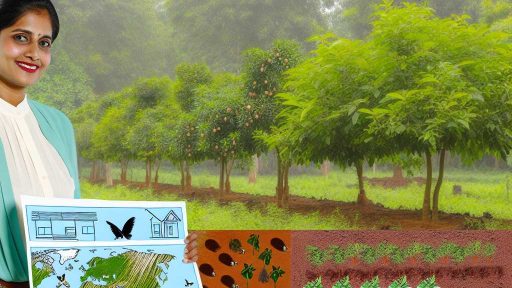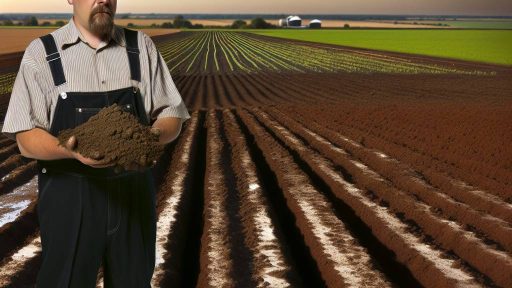Introduction to Smart Greenhouse Technologies and Their Importance in Climate Resilience
Smart greenhouse technologies revolutionize modern agriculture.
They enhance plant growth while conserving resources.
In times of climate change, these technologies are invaluable.
They help farmers adapt to unpredictable weather patterns.
Moreover, smart greenhouses provide optimal growing conditions year-round.
The Role of Technology in Agriculture
Technology plays a crucial role in food production.
It helps farmers manage crops more efficiently.
In addition, automation reduces labor costs significantly.
This is especially important as the demand for food increases.
Enhancing Resource Efficiency
Smart greenhouses utilize water and energy more efficiently.
They often incorporate rainwater harvesting systems.
This approach minimizes the impact on local water sources.
Furthermore, advanced climate control systems optimize energy use.
Improving Crop Resilience
Smart greenhouses protect crops from extreme weather.
For example, they can shield plants from frost or excessive heat.
Transform Your Agribusiness
Unlock your farm's potential with expert advice tailored to your needs. Get actionable steps that drive real results.
Get StartedThis resilience translates to more reliable harvests for farmers.
Consequently, food security improves in vulnerable regions.
Driving Sustainable Practices
These technologies promote sustainable agricultural practices.
For instance, they often employ hydroponics or aquaponics.
These methods use less water than traditional soil farming.
As a result, they reduce environmental degradation.
Importance of Smart Greenhouse Technologies
Smart greenhouse technologies are crucial for climate resilience.
They offer innovative solutions to modern agricultural challenges.
Their benefits extend beyond individual farms to global food systems.
Investing in these innovations paves the way for a sustainable future.
Key Features of Smart Greenhouses
Automation and Control Systems
Smart greenhouses utilize advanced automation technologies to enhance efficiency.
These systems regulate temperature, humidity, and light levels automatically.
For instance, sensors monitor environmental conditions in real time.
Based on data, the greenhouse can adjust settings without human intervention.
This leads to optimal growing conditions and improved crop yields.
Moreover, automation reduces labor costs for farmers significantly.
Farmers can program irrigation schedules to conserve water effectively.
Automated systems also enable remote monitoring and management.
This feature allows farmers to stay connected to their crops anywhere.
Additionally, control systems can predict weather changes and adapt accordingly.
As a result, smart greenhouses provide resilience against climate fluctuations.
Farmers benefit from data-driven insights into their operations.
In essence, technology empowers them to make informed decisions.
Consequently, investments in smart greenhouses often yield high returns.
Showcase Your Farming Business
Publish your professional farming services profile on our blog for a one-time fee of $200 and reach a dedicated audience of farmers and agribusiness owners.
Publish Your ProfileThe Role of IoT in Enhancing Greenhouse Efficiency
Overview of IoT Innovations
IoT technologies revolutionize greenhouse operations.
They enhance monitoring and management of environmental conditions.
As a result, farmers can optimize resource use and crop yield.
Data-Driven Decision Making
IoT devices collect real-time data on temperature and humidity.
Analytics tools help farmers make informed decisions quickly.
This data enables precise interventions to improve plant health.
Integration of Smart Sensors
Smart sensors are key components of IoT systems.
They continuously track soil moisture levels and nutrient content.
This information allows for timely irrigation and fertilization.
Remote Monitoring Capabilities
Farmers can monitor greenhouse conditions remotely through apps.
This capability ensures timely responses to changing conditions.
Additionally, it reduces the need for constant physical oversight.
Automated Control Systems
Automated systems control ventilation and lighting intelligently.
They adjust settings based on real-time environmental data.
This automation promotes energy efficiency and optimizes growth conditions.
Improving Pest and Disease Management
IoT technologies help in early detection of pests and diseases.
Farmers receive alerts and actionable insights via connected devices.
This proactive approach minimizes crop losses and reduces pesticide use.
Collaboration and Knowledge Sharing
IoT facilitates collaboration among farmers, researchers, and experts.
They can share insights and experiences through online platforms.
This knowledge exchange fosters innovation and best practices in farming.
Delve into the Subject: Managing Soil-Borne Diseases to Protect Agricultural Land Investments
Sustainable Energy Solutions for Smart Greenhouses
Integrating Solar Energy
Solar panels are a game-changer for smart greenhouse operations.
They harness sunlight and convert it into electricity efficiently.
This renewable energy source significantly reduces operational costs.
Moreover, excess energy can be stored or sold back to the grid.
Farmers benefit from tax incentives when investing in solar technology.
Thus, solar energy facilitates sustainable growth in agriculture.
Implementing Wind Power
Wind turbines are another viable energy source for greenhouses.
They can generate substantial electricity in areas with high wind speeds.
This setup can complement solar systems to ensure reliable energy supply.
Farmers can enjoy lower energy costs and reduced carbon footprints.
Moreover, wind energy contributes to energy independence.
Innovations are making wind technology more accessible and affordable.
Combining Solar and Wind Systems
Integrating solar and wind technologies creates a robust energy solution.
This hybrid approach maximizes energy production throughout the year.
During cloudy days, wind can compensate for reduced solar output.
Conversely, solar can provide energy during calm, sunny periods.
Therefore, diversification enhances sustainability and energy resilience.
Smart Energy Management Systems
Advanced management systems optimize energy usage in greenhouses.
Showcase Your Farming Business
Publish your professional farming services profile on our blog for a one-time fee of $200 and reach a dedicated audience of farmers and agribusiness owners.
Publish Your ProfileThey monitor and regulate energy consumption in real-time.
This technology helps in minimizing waste and maximizing efficiency.
Farmers can track energy production and usage via mobile apps.
Furthermore, predictive analytics can anticipate energy needs.
Investing in smart systems undoubtedly leads to better resource management.
Future Trends in Greenhouse Energy
As technology advances, renewable energy solutions will evolve.
Innovative materials for solar panels are becoming more efficient.
Future wind turbines may be quieter and more space-efficient.
Farmers should stay informed about emerging technologies.
This knowledge will empower them to make the best investment choices.
Ultimately, sustainable energy solutions drive climate resilience in agriculture.
Learn More: Agroforestry Strategies for Climate-Resilient Land Development
Climate Monitoring and Data Analytics
Importance of Climate Monitoring
Climate monitoring plays a crucial role in modern agriculture.
It helps farmers make informed decisions based on accurate data.
Additionally, it enables the optimization of growing conditions.
Farmers can track environmental variables such as temperature and humidity.
Consequently, they can respond swiftly to changing conditions.
Data Analytics for Enhanced Decision-Making
Data analytics empowers farmers to interpret vast amounts of information.
They can analyze growth patterns and environmental impacts effectively.
Using sophisticated algorithms, farmers can identify trends over time.
These insights allow for predictive modeling of future conditions.
Farmers can plan ahead, improving yields and reducing waste.
Tools and Technologies in Climate Monitoring
Various tools are available to facilitate climate monitoring.
Sensors collect real-time data from the greenhouse environment.
Automated systems can adjust climate controls based on this data.
For example, smart thermostats regulate temperature efficiently.
Moreover, soil moisture sensors optimize irrigation schedules.
Integrating Data with IoT Technologies
The Internet of Things (IoT) enhances data collection efforts.
IoT devices connect multiple sensors and systems seamlessly.
This integration enables comprehensive monitoring across the farm.
Farmers receive alerts about potential issues in real-time.
Consequently, they can address problems before they escalate.
Case Studies in Successful Implementation
Many farms have successfully implemented climate monitoring technologies.
For instance, GreenLeaf Farms uses data analytics for crop rotation.
Their approach has increased yield by 15% over the past year.
Similarly, EcoGrowers focuses on water conservation through smart sensors.
This has led to a reduction in water usage by 20% annually.
Future Trends in Climate Monitoring
Future advancements in climate monitoring are promising.
AI and machine learning will likely enhance prediction capabilities.
Farmers can expect more robust models to simulate climatic impacts.
Showcase Your Farming Business
Publish your professional farming services profile on our blog for a one-time fee of $200 and reach a dedicated audience of farmers and agribusiness owners.
Publish Your ProfileMoreover, collaboration among farmers could lead to shared data insights.
Such initiatives will strengthen community resilience against climate challenges.
Find Out More: Drought Management Strategies for Sustainable Agricultural Land Investments
Water Management Techniques
Advanced Irrigation Systems
Efficient irrigation systems optimize water usage on farms.
They ensure crops receive the necessary moisture consistently.
Technologies like drip irrigation deliver water directly to roots.
This method minimizes water waste and reduces evaporation.
Furthermore, smart controllers adjust watering schedules automatically.
They respond to real-time climate data and soil moisture levels.
As a result, farmers can significantly reduce water consumption.
Installing these systems can enhance crop yields and quality.
Rainwater Harvesting
Rainwater harvesting systems capture and store rainwater effectively.
This technique relies on roofs and paved areas to collect water.
After collection, water undergoes filtration for safe use.
Farmers can utilize harvested rainwater for irrigation needs.
This practice reduces reliance on traditional water sources.
Moreover, rainwater harvesting systems help alleviate runoff issues.
They contribute to sustainable water management practices.
Benefits of Smart Water Management
Implementing advanced systems creates resilient farming environments.
Farmers can adapt to changing climate conditions effectively.
In addition, these systems promote overall farm sustainability.
Efficiency leads to increased profits and reduced operational costs.
As climate change threatens farming, technology offers practical solutions.
Uncover the Details: How Sustainable Irrigation Improves Soil Health and Crop Yields

Integration of Hydroponics and Aquaponics in Smart Greenhouses for Resource Efficiency
Understanding Hydroponics
Hydroponics is a method of growing plants without soil.
In this system, nutrients are delivered directly to roots through water.
This technique significantly reduces water usage compared to traditional farming.
Moreover, it allows for year-round crop production.
Farmers can optimize plant growth using precise nutrient control.
Exploring Aquaponics
Aquaponics combines aquaculture with hydroponics.
This system creates a symbiotic environment between fish and plants.
Fish waste provides organic nutrients for plant growth.
In return, plants help filter and clean the water for the fish.
This closed-loop system enhances resource efficiency.
Benefits of Combining Hydroponics and Aquaponics
The integration of these systems boosts sustainability in agriculture.
They reduce dependency on chemical fertilizers and pesticides.
Furthermore, they minimize land usage while maximizing yield.
Combining these methods enhances biodiversity within the greenhouse.
Additionally, it offers a continuous food supply regardless of the growing season.
Technology and Management
Smart greenhouse technologies play a crucial role in these systems.
Showcase Your Farming Business
Publish your professional farming services profile on our blog for a one-time fee of $200 and reach a dedicated audience of farmers and agribusiness owners.
Publish Your ProfileAutomation allows for the optimal management of nutrient delivery.
Climate control systems ensure ideal growing conditions.
Advanced monitoring tools track plant health and growth rates.
Farmers can make data-driven decisions for resource optimization.
Challenges and Considerations
Despite the benefits, challenges exist in implementing these systems.
Initial setup costs can be a barrier for some farmers.
Training and knowledge on system management are essential.
Farmers must also consider local regulations regarding aquaculture.
Moreover, market access for aquaponics products can be limited.
Future Outlook
As climate change impacts agriculture, these systems hold promise.
They enhance food security and reduce environmental footprints.
Collaboration among farmers, researchers, and policymakers is vital.
Investments in these smart technologies will reshape farming for the future.
Ultimately, integrating hydroponics and aquaponics can revolutionize resource efficiency in agriculture.
Case Studies: Successful Implementation of Smart Greenhouse Technologies Worldwide
Innovative Solutions in Europe
In the Netherlands, smart greenhouse technologies have revolutionized production.
Local farmers implement climate control systems to optimize growth conditions.
This technology includes automated ventilation and precise lighting systems.
As a result, yields have increased significantly while reducing resource consumption.
Advancements in North America
In California, vineyards embrace smart technology for efficient irrigation.
Farmers utilize soil moisture sensors to monitor water needs effectively.
Consequently, farmers conserve water while maximizing grape quality.
This innovation boosts sustainability and improves profitability in the region.
Successful Projects in Asia
China’s approach to smart greenhouses offers valuable lessons for adaptation.
Farmers integrate IoT systems to monitor and control internal environments.
These enhancements lead to better crop management and drought resilience.
Additionally, the use of artificial intelligence predicts optimal planting times.
Collaborative Efforts in Australia
In Australia, researchers partner with farmers to implement smart technology.
This collaboration focuses on developing advanced crop monitoring systems.
Utilizing drones and remote sensing, farmers can assess crop health efficiently.
Such innovations increase productivity while addressing climate challenges.
Benefits Observed Globally
Overall, smart greenhouse technologies provide several key benefits.
- Increased crop yields through environmental optimization.
- Advanced resource management, especially water and nutrients.
- Enhanced climate resilience against extreme weather conditions.
- Improved sustainability and reduction of carbon footprints.
Indeed, these technologies are shaping the future of global agriculture.
Future Trends in Smart Greenhouse Farming
Adoption of Climate-Responsive Technologies
The agricultural sector increasingly embraces climate-responsive technologies.
These tools enhance efficiency and resilience against climate change.
Technologies like precision agriculture and IoT devices are gaining traction.
Farmers utilize data analytics to optimize resource management.
This leads to improved crop yields while conserving water and energy.
Integration of Automation and Robotics
Automation is revolutionizing greenhouse operations.
Robotic systems automate planting, monitoring, and harvesting tasks.
This reduces labor costs and increases operational efficiency.
Showcase Your Farming Business
Publish your professional farming services profile on our blog for a one-time fee of $200 and reach a dedicated audience of farmers and agribusiness owners.
Publish Your ProfileAdditionally, drones support field monitoring for crop health.
Consequently, farmers gain real-time insights to make informed decisions.
Implementation of Advanced Climate Control Systems
Advanced climate control systems play a vital role in smart greenhouses.
These systems regulate temperature, humidity, and light levels effectively.
They utilize sensors to maintain optimal growing conditions.
This improves plant health and productivity consistently.
Moreover, energy-efficient systems reduce greenhouse emissions significantly.
Utilization of Renewable Energy Sources
Renewable energy sources are becoming integral to greenhouse operations.
Solar panels and wind turbines provide sustainable power solutions.
Using these sources decreases reliance on fossil fuels.
This shift promotes environmental sustainability within the agricultural sector.
Furthermore, it lowers operational costs over time.
Emphasis on Sustainable Practices
The focus on sustainable practices is paramount in smart greenhouse farming.
Farmers are adopting organic farming methods more frequently.
Sustainable practices enhance soil health and biodiversity.
Additionally, they contribute to reducing chemical usage.
This trend aligns with consumer demand for eco-friendly produce.
Research and Development of Innovative Crops
Research and development drive innovation in crop production.
Biotechnology plays a crucial role in developing resilient plant varieties.
These crops can withstand extreme weather conditions and diseases.
Consequently, this helps secure food supplies in uncertain climates.
Moreover, genetic modifications can enhance nutritional profiles for consumers.
Additional Resources
COP 29 Fact Sheet: AIM for Climate Innovation Sprints 52 AIM for …
Biden-Harris Administration Announces an Additional $325 Million …




